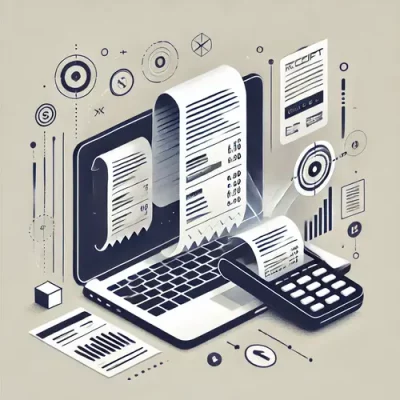Key Takeaways
- Automated receipt data extraction eliminates the need for manual data entry, saving time and reducing errors.
- OCR-powered tools can scan receipt details into Excel, CSV, or QBO.
- Using receipt scanning software for automated data entry improves accuracy, streamlines bookkeeping, and reduces labor costs.
- With tools like DocuClipper, you can quickly process receipts in bulk and integrate data with accounting platforms like QuickBooks and Xero.
What is Receipt Data Extraction?
Receipt data extraction is the process of capturing and organizing essential information from a receipt. This includes transaction details, payment information, customer and seller data, taxes, and compliance-related statements.
The process can either be manual or automated when extracting receipt information.
The data can be compiled or imported to a working spreadsheet or accounting software when all accounting is done electronically.
Types of Data Extracted from Receipts
Receipts contain much information that can be extracted, some are important to almost any business and some are important only to a few.
Here we discuss the key data points you might need when tracking your business or client’s cashflow:
1. Transaction Details: These details contain specifics of the transaction for tracking.
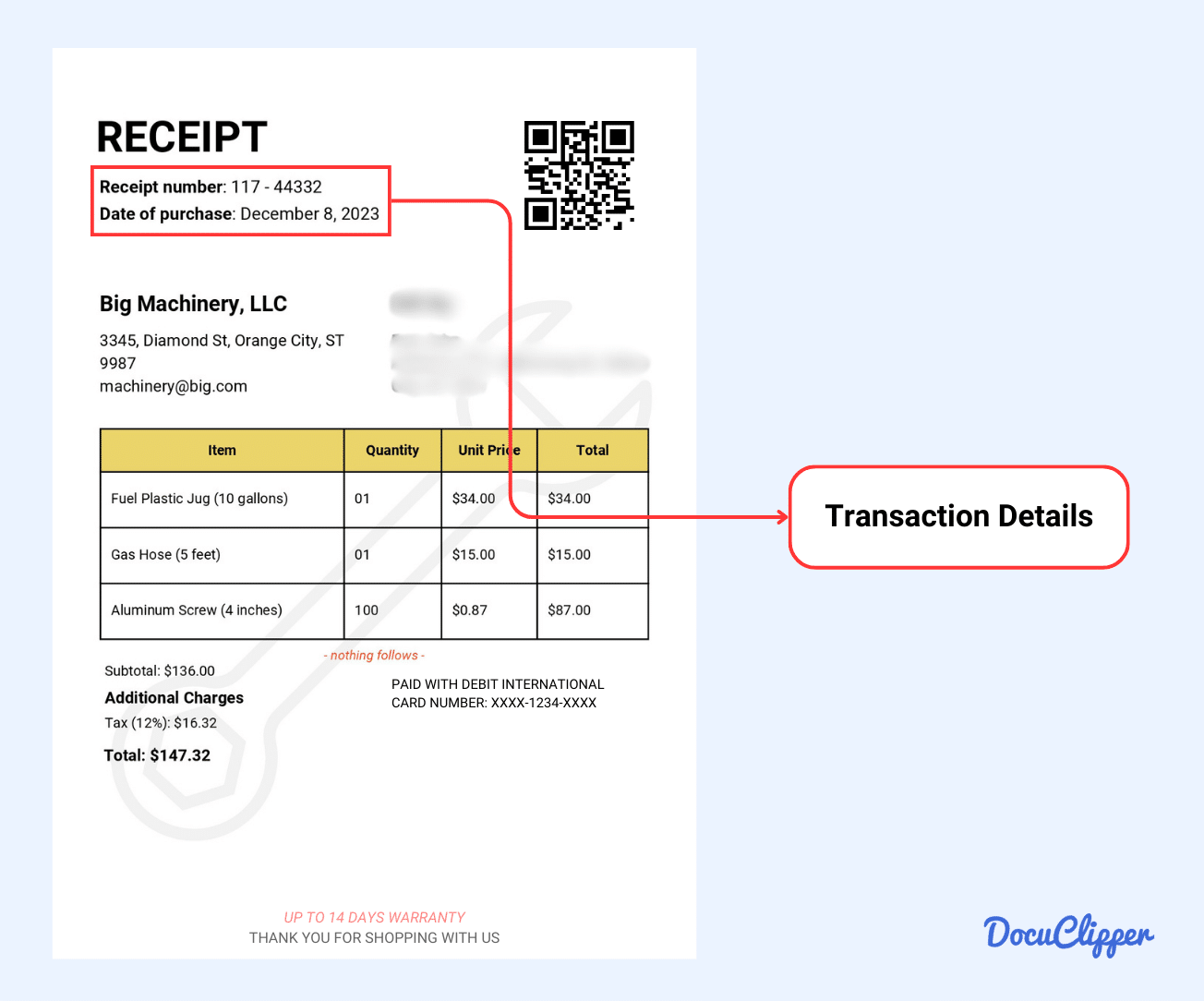
- Date and Time: Shows when the purchase occurred.
- Transaction ID: A unique code for referencing the specific transaction.
- Store/Business Name: The business name where the purchase was made.
- Location Details: The address of the business for verification purposes.
2. Purchase Information: Details about the goods and services purchased.
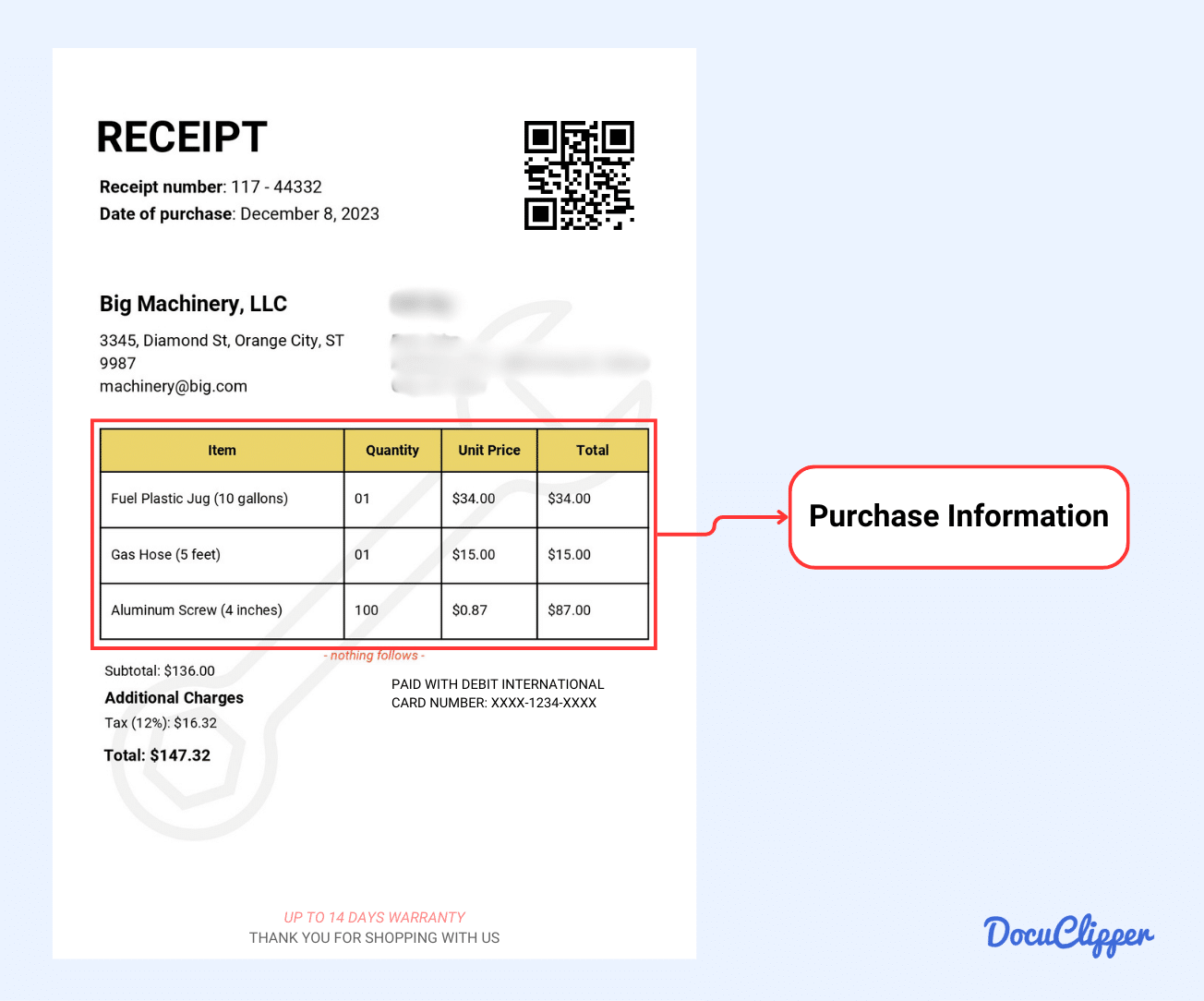
- Item Descriptions: A list of goods or services purchased including details such as identification features and specifications.
- Quantity: The number of each item purchased, which can be in volume, weight, pieces, hours, etc.
- Unit Price: The cost of one unit of the product or service.
- Total Price per Item: The total cost for each item is based on quantity and unit price.
3. Financial Data: The financial breakdown of the cost and how it adds up.
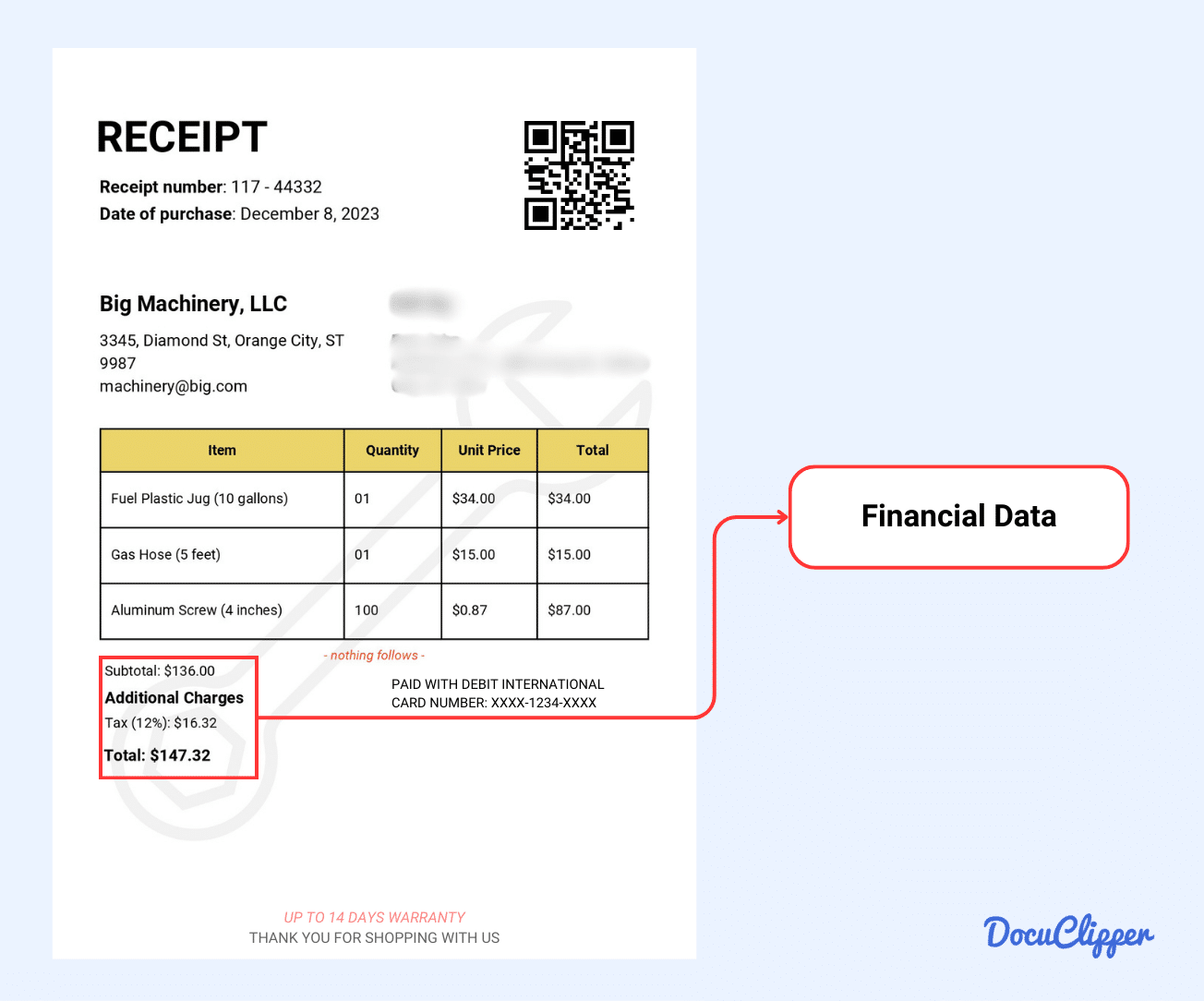
- Subtotal: The total cost of the items purchased without taxes, discounts, or additional fees.
- Discounts/Promotions: Any price cuts, such as sales or loyalty rewards.
- Taxes: The tax charged applied, often broken down by type or rate.
- Total Amount Paid: The final cost after taxes, discounts, and fees.
4. Payment Information: Record of how the payment was made for tracking.
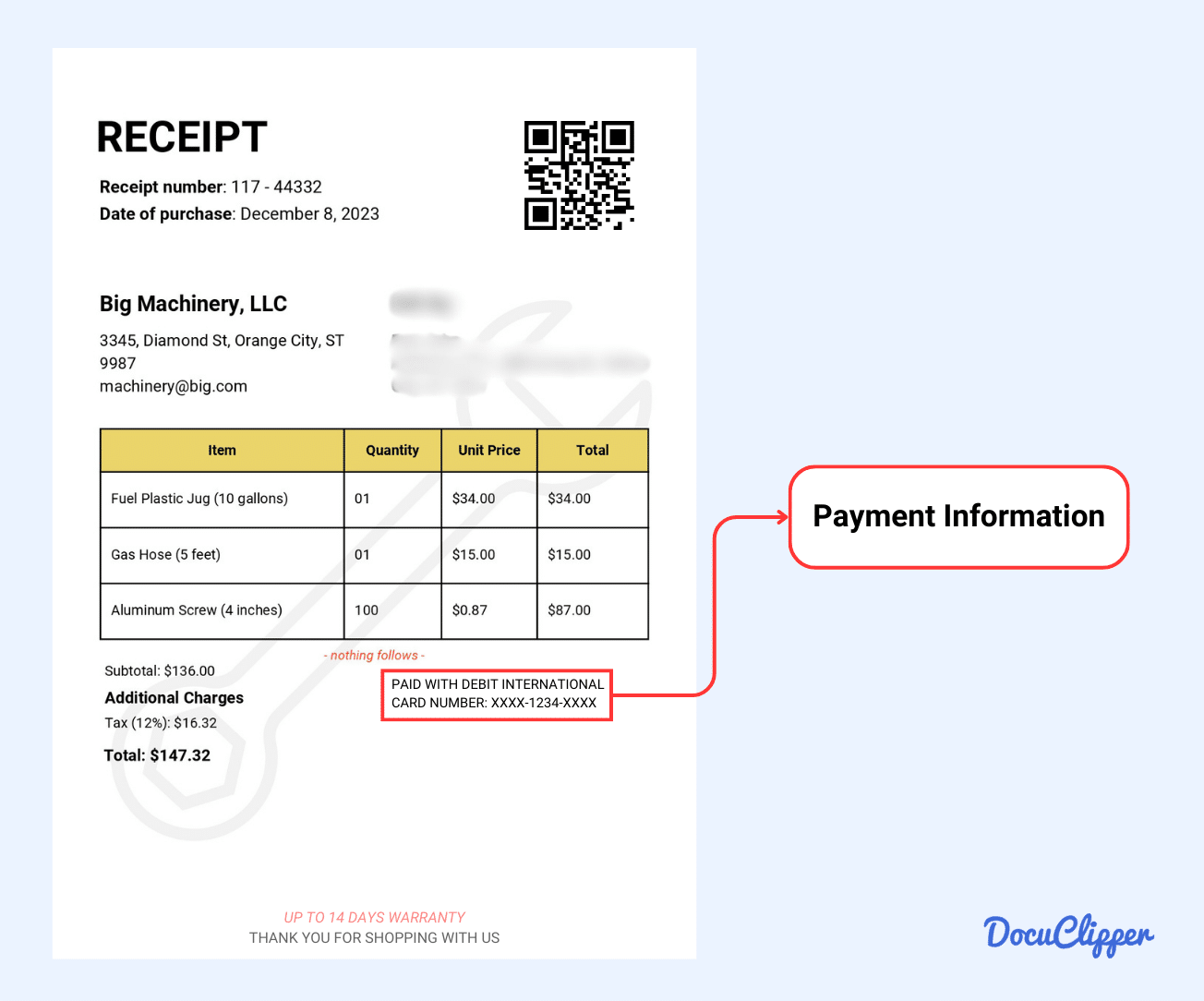
- Payment Method: Displays mode of payment done in the purchase, such as cash, card, or mobile wallet.
- Card Details: Incomplete information about the card used for payment (e.g., card type, last four digits).
- Change Given: The amount of cash returned to the customer, if applicable.
5. Business/Operational Information: Usual branding and additional information from the business.
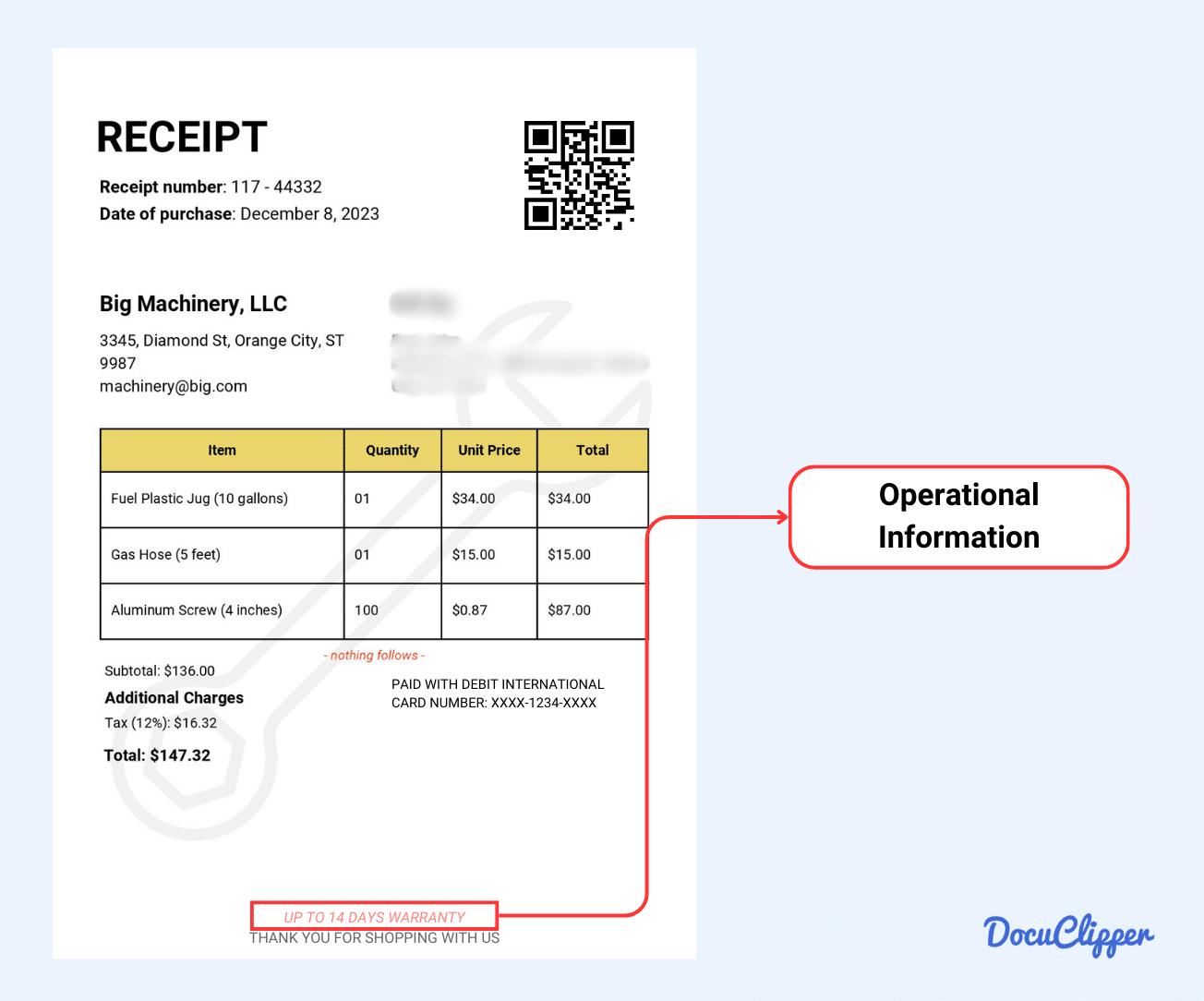
- Logo: The logo or symbol of the business for branding purposes.
- Receipt Header/Footer Messages: Custom messages like “Thank you for shopping with us!”
- Cashier/Employee ID: Information about the staff member who processed the transaction.
6. Machine-Readable Data: Data within the receipt encoded that can be used for analysis.
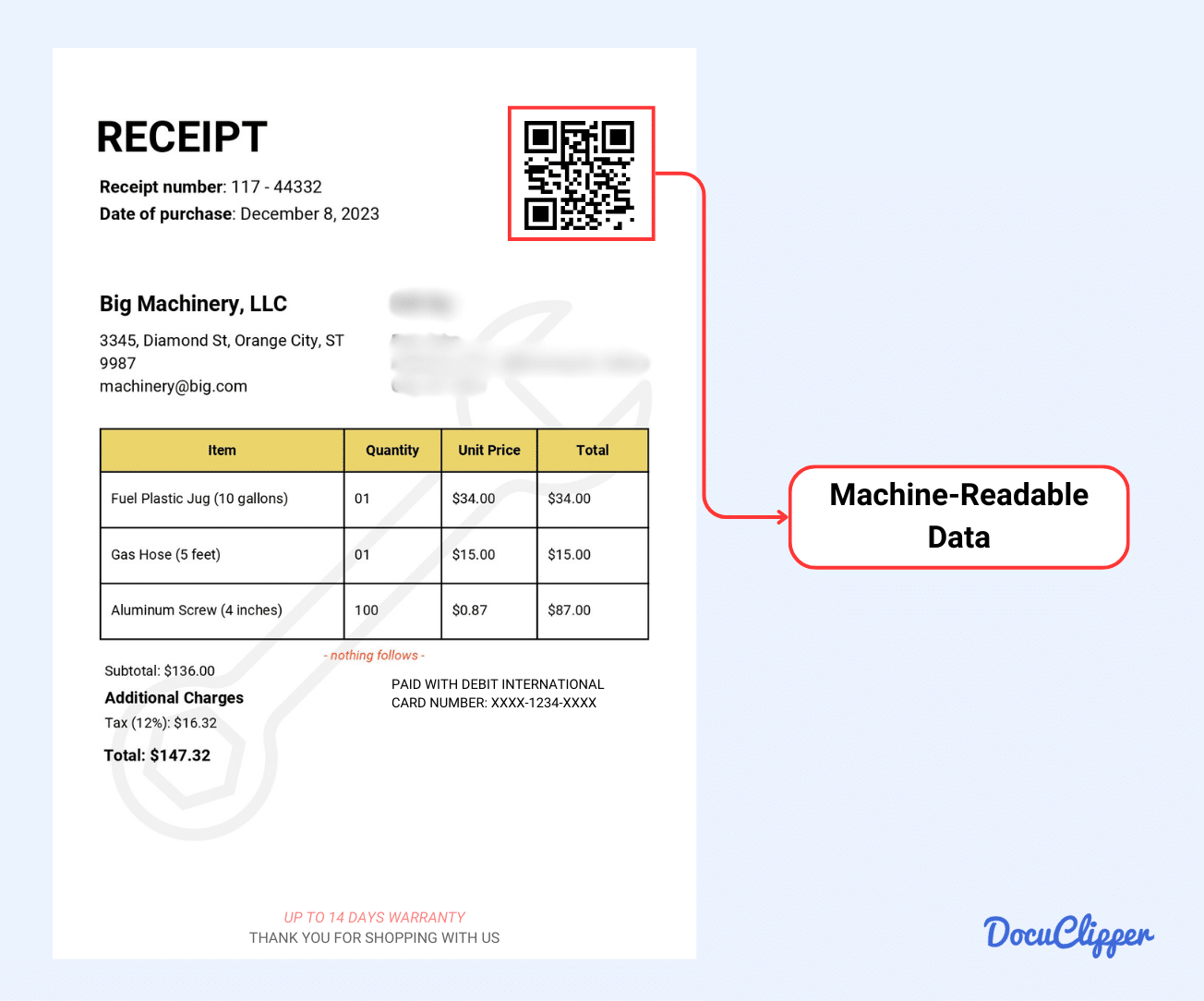
- Item Categories: Categorized groupings of purchased items (e.g., groceries, electronics).
- QR Codes: Encoded data for easy access to digital receipts or additional details.
- Barcodes: Used for inventory tracking or receipt scanning.
- Digital Receipt Identifiers: Unique codes such as a combination of numbers, letters, and symbols.
7. Customer Information: Containing details about the customer purchasing.
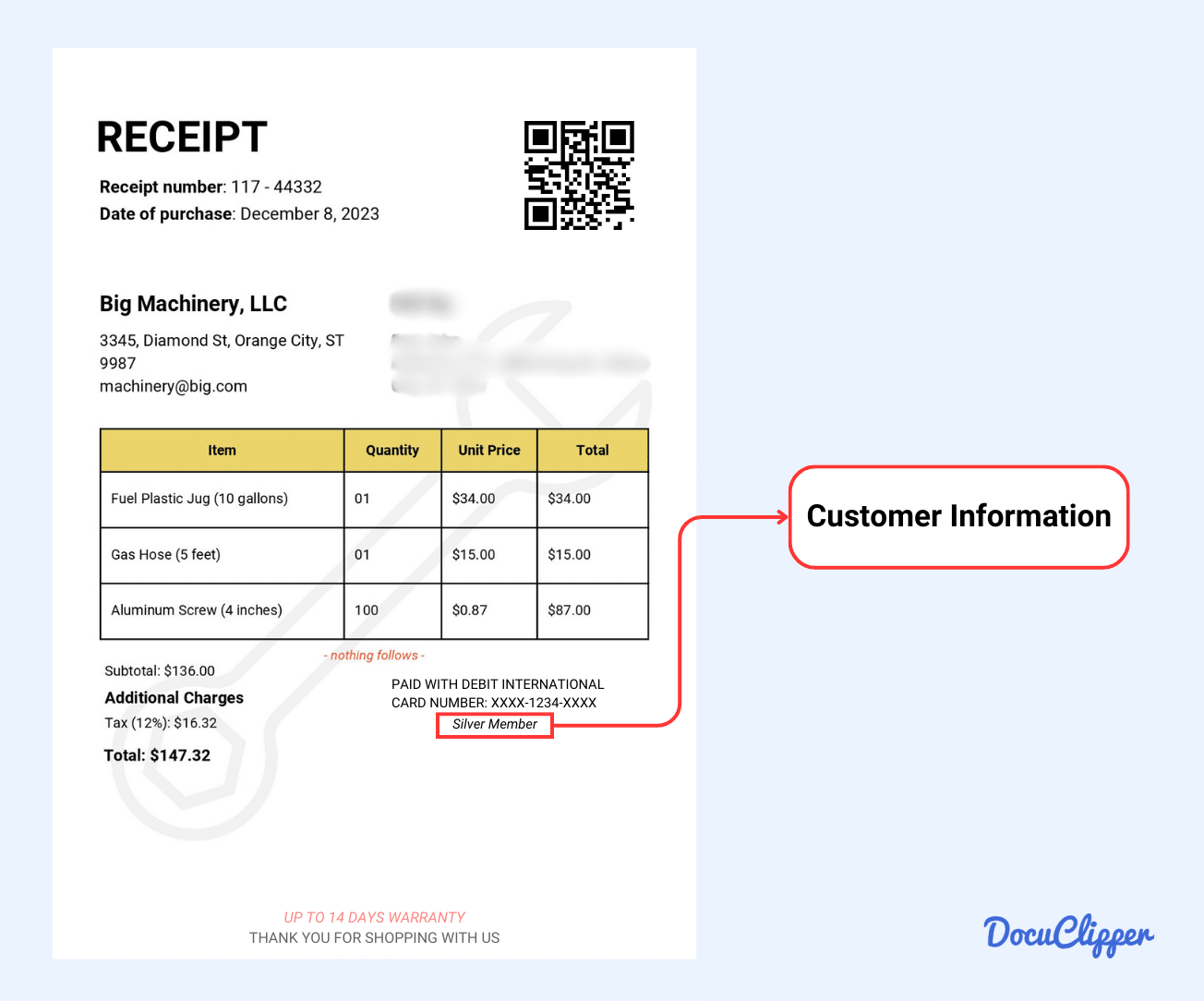
- Loyalty Program Details: Points earned or rewards applied to the transaction.
- Customer Account Numbers: Identifiers for customer accounts or profiles.
- Membership Status: Information on the customer’s membership level, if applicable.
- Points Earned or Redeemed: Details of rewards accumulated or used during the purchase.
- Customer-specific discounts: Discounts given to partners, loyal customers, or members of the business.
8. Transaction-Specific Details: Additional information that varies by the type of transaction or business.
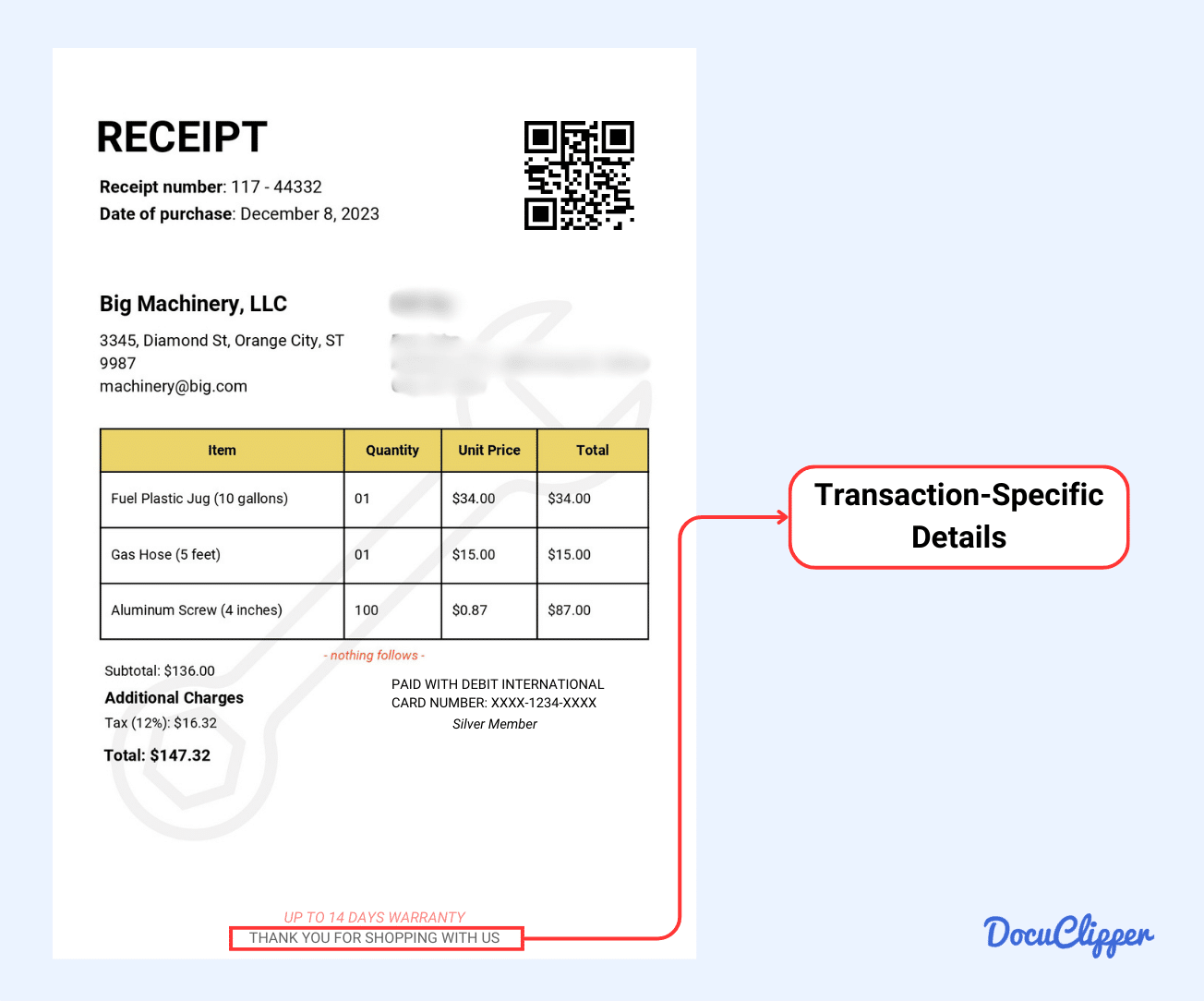
- Server or Cashier Name/ID: Identifies the employee managing the transaction.
- Table Number (for Restaurants): Assigns the purchase to a specific table.
- Order Number: A reference number for order tracking.
- Delivery Information: Details about the delivery address or instructions, if applicable.
- Special Instructions: Any custom notes or requests attached to the order.
9. Other Metadata: General information about the receipts that will be useful for bookkeeping and auditing purposes.
- Receipt Type: Indicates whether the receipt is for a purchase, refund, or exchange.
- Return Policy: Outlines the store’s return or exchange terms.
- Warranty Information: Covers warranties associated with the purchased products.
- Notes or Comments: Any additional information added to the receipt.
- Promotional Messages: Includes ads, coupons, or offers printed on the receipt.
- Eco-Friendly Details: Information on whether the receipt was printed on recycled paper or provided digitally.
- Authentication Elements: Security features that ensure the receipt’s authenticity and integrity.
Challenges in Receipt Data Extraction
Receipts may look simple but there are many accounts receivable personnel that find difficulties in extracting data because of these reasons:
- Receipt format diversity: Not all receipts have the same format. Each company and business formats its receipts and presents its information differently, making it difficult to single the specifics.
- Differences in receipt files: Sellers can give receipts in paper (print or handwritten), PDF files, or e-receipts (email attachments). These different formats can be problematic when gathering information, as you may be compelled to switch from a computer to a receipt stub.
- Hand-written receipts: Some businesses that have not adapted to modern ways still give out hand-written receipts. Making it difficult when someone has bad penmanship.
- Poor Print Quality: Faded or blurred receipts from faulty printers make reading and extracting data difficult. This becomes an issue when reading the characters.
- Inconsistent Use of Tax and Discount Fields: Different stores put discounts and promos differently in their receipts. Governments also offer tax breaks during seasons adding complexities to the receipt.
- Manual Errors in Entry and Validation: Manual receipt data entry is prone to errors and typing receipt data into a spreadsheet sometimes be inaccurate. This depends a lot on the proficiency of your data entry personnel.
Methods of Receipt Data Extraction
There are two ways you can extract the information that you need from receipts, and both are widely used by accountants. They each have their benefits and downsides:
- Manual: Manual receipt data extraction involves manually typing the information in a receipt into a spreadsheet. This process is time-consuming, error-prone, and not scalable, although some accountants might opt for it because humans still understand some nuances.
- Automated (OCR): Automated receipt processing uses OCR receipt scanning software. This method (using a receipt parser) is widely adopted because it is fast, cost-effective, and generally more accurate than manual extractions. Yet it is easily influenced by document resolution, format, and clarity.
Automated Receipt Data Extraction
Automated receipt data extraction is the process of extracting the receipt data with the use of software like OCR and AI. This surpasses the manual method by a margin in terms of accuracy, speed, and scalability
Here’s how it usually works
- Receipt Capture: Receipts are collected from various sources, including paper copies, emails, and mobile apps. Scanning, photographing, or uploading them creates a digital record for extraction.
- Receipt Data Extraction: You can use OCR technology to extract necessary information like amounts, items, and dates from PDF receipts.
- Data Validation: The system or person checks if the extracted data is accurate by matching it with invoices, inventory, and bank statements. It also verifies calculations, discounts, and tax charges.
- ERP/Accounting Integration: Once approved, the information can then be integrated into databases like ERP systems or accounting software for further receipt management analysis and reporting.
- Storage & Compliance: Data is then stored in a hard drive or cloud storage where it is stored for future uses. This is often brought up when there are internal investigations within a business.
Benefits of Automated OCR Receipt Scanning Software
Here are the main reasons why businesses are shifting to automation in recept data extraction.
- Eliminates Manual Errors: OCR accurately extracts receipt details, reducing mistakes caused by manual data entry by up to 99%, even when dealing with different receipt formats.
- Improves Productivity: OCR processes large batches of documents in seconds, freeing up employees from data entry tasks that can take up to 45% of their workday.
- Lower Costs: Automating receipt processing cuts labor expenses. While outsourcing data entry costs $6 per hour, an OCR subscription costs about $40 per month.
- Handles High Volume: OCR allows you to process hundreds of receipts at the same time, making it highly scalable and beyond manual capacity.
- Improves Data Organization: Extracted receipt data is stored digitally, making it easy to search, retrieve, and integrate with accounting systems for better record-keeping.
Top 5 Receipt Data Extraction Software
Here is the best software available in the market for extracting data fro receipts:
DocuClipper
DocuClipper is the leading receipt parser that extracts receipt data into formats such as Excel, CSV, and QBO with an impressive 97% accuracy rate.
You can seamlessly sync DocuClipper with QuickBooks to import receipts directly, eliminating manual data entry.
Powered by advanced OCR technology, DocuClipper streamlines receipt scanning. It supports batch processing for faster file conversion and integrates via API with leading accounting platforms like QuickBooks, Xero, and Sage.
AutoEntry
AutoEntry is a specialized data automation tool designed to streamline accounting processes by extracting line items and publishing receipt data to major accounting software platforms. It automates receipt data entry, reducing manual workload and improving accuracy.
Dext
Dext is a software designed to improve accounting speed and efficiency by automating receipt data extraction and management. It helps accountants and businesses process receipts faster with tools that sort, categorize, and publish data directly to accounting software.
Klippa
Klippa is an all-in-one expense management solution that simplifies how businesses handle receipts. It automates receipt processing, reducing manual or outsourced data entry and improving accuracy.
Nanonets
Nanonets is an AI automation tool made to simplify receipt processing. It uses machine learning to extract and convert key receipt details into structured data for seamless accounting and expense management.
Conclusion
Receipt data extraction is already an integral part of your accounting task for your business or bookkeeping practice. The traditional way of doing has been manual and there are many disadvantages in committing to it.
Nowadays, modern accounting and bookkeeping teams have already adopted automation in their receipt data extraction process. Effectively eliminating extra costs, windows of errors, and human limitations.
Automate Your Receipt Data Extraction with DocuClipper
DocuClipper is a Receipt OCR tool that effectively extracts data from PDF files. This extracts data by converting PDF receipts into editable formats such as XLS, CSV, and QBO.
This receipt scanning software is highly accurate and capable of accuracy for up to 97% across different receipt formats. It is scalable and capable of converting hundreds of PDF files into a spreadsheet in just a few seconds.
With its receipt OCR API, you can integrate this tool across all ERP and accounting systems.
DocuClipper not only covers receipts for PDF conversions, but it can also convert bank statements, invoices, tax forms, credit card statements, and brokerage reports.
FAQs about Receipt Data Extraction
Frequently asked questions about receipt data extraction:
How to extract data from receipts?
You can extract data from receipts manually by entering details into a spreadsheet or accounting software, but this is time-consuming and error-prone. A better option is using OCR-powered receipt scanning software, which automatically captures and converts receipt data into structured formats like Excel, CSV, or QBO for easy processing.
What is the meaning of receipt of data?
Receipt of data refers to the process of receiving and acknowledging data from a source. In accounting and finance, it often means capturing transaction details from receipts for record-keeping, auditing, or processing. This can be done manually or through automated receipt data extraction using OCR technology.
What information can be obtained from a receipt?
A receipt contains key details such as transaction date, time, store name, item descriptions, quantity, unit price, total amount, taxes, discounts, payment method, and sometimes customer information. It may also include loyalty points, order numbers, and business-specific details like return policies or promotional messages.
How do I convert a receipt to digital?
You can convert a receipt to digital by scanning it with a mobile app, taking a photo, or uploading it to receipt scanning software. OCR technology extracts key details and converts them into structured formats like Excel, CSV, or QBO, making the data easier to store, manage, and integrate with accounting software.
What data is included on the receipt?
A receipt includes transaction details such as the date, time, store name, item descriptions, quantity, unit price, total amount, taxes, and discounts. It also contains payment details like the payment method, last four digits of a card, and change given. Additional information may include loyalty points, order numbers, and return policies.
Is a receipt personal data?
A receipt may contain personal data if it includes identifiable details such as a customer’s name, loyalty account number, or payment card information. While most receipts only show transaction details, businesses handling receipts must ensure compliance with data protection regulations to safeguard any personal information.
Keywords to mention: receipt data extraction, receipt data entry, receipt processing, receipt scanning, manual receipt processing, automated receipt processing, receipt management, receipt, OCR, OCR accuracy, bookkeeping data entry, automated data entry, manual data entry
